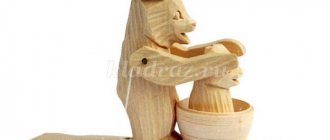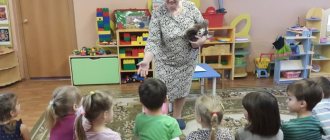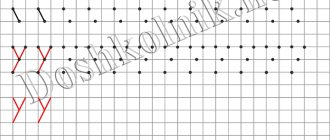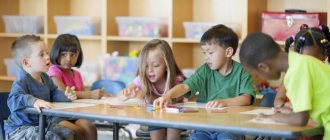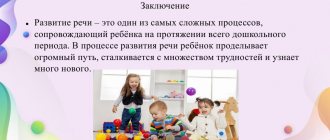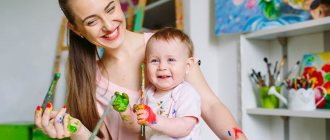Summary of GCD in the middle group on the topic “Gifts of Autumn - Vegetables and Fruits”
Summary of GCD in the middle group
"Autumn Gifts - Vegetables and Fruits"
Educational field "Communication".
Target:
To consolidate children's knowledge of the concepts: “vegetables”, “fruits”.
Tasks:
1. Consolidate children’s knowledge about the signs of autumn.
2. Introduce children to a healthy lifestyle. Form the idea that vegetables and fruits contain vitamins, and eating them is good for health.
3. Practice quantitative calculation within 3, compare two groups of objects.
4. Consolidate knowledge of geometric shapes: circle, rectangle, triangle.
Equipment:
1. Envelope with a letter;
2. Basket with vegetables and fruits, vase, plate;
3. Toy (doll)
;
4. Sheets with drawings of vases and plates, pencils.
Move:
Educator: Guys, I suggest you listen to the poem.
"The breeze sweeps the paths
And swirls golden leaves
What happened in nature guys?
Tell me, I don’t understand.”
That's right, it's autumn. Guys, tell me by what signs can we determine that autumn has come? What happens in nature in autumn? ( Children's answers: It is raining outside, it has become cold, a cold wind is blowing, the leaves turn yellow and fall off, the sun is shining but does not warm, birds are flying to warmer climes, animals are preparing for winter, people are harvesting and preparing vegetables and fruits for the winter) .
Well done guys, you listed many signs of autumn.
Tell me, children, what autumn months do you know? Let's remember and name each month .
(Children's answers, repeat all together: September, October, November) .
Children, today the doll Katya came to visit us. (Children greet the doll)
. Katya, what is this in your hands?
Doll: Guys, I received a letter in the mail, but I don’t know how to read yet. Help me please.
Educator: Guys, can we help Katya? (Reads the letter).
“Hello, granddaughter Katenka!
We are waiting for you to visit. We really need your help in harvesting. Your grandparents." The guys and Katya's grandparents live in the village. Do you have grandparents? Where do they live? (children's answers)
What vegetables do you know?
(children's answers)
.
(Presentation “Vegetables and Fruits” Slide 2)
.
What fruits? (children's answers)
.
(Presentation “Vegetables and Fruits” Slide 3)
.
Where do vegetables grow? (vegetable garden)
.
What about fruits? (garden) (Presentation “Vegetables and Fruits” Slide 4)
.
Let's remember why it is necessary to eat vegetables and fruits? (children's answers)
.
Doll: Guys, I understand. To be healthy you need to eat vegetables and fruits. I really love salads and juice.
Educator: Guys, we have a basket of vegetables and fruits. Let's put vegetables in a plate for making a salad, and fruits in a vase for juice. (Children complete the task)
.
Tell us what vegetables are on the plate. (Children's answers)
.
What fruits are in the bowl? (Children's answers)
.
Look at what geometric shapes our vegetables and fruits look like? (Children's answers)
.
(Presentation “Vegetables and Fruits” Slide 6)
.
Guys, what else can you make from fruits? (jam, compote).
(Presentation “Vegetables and Fruits” Slide 7)
.
Doll: Thanks, guys! Now I know how to distinguish between vegetables and fruits and can make a vegetable salad and cook fruit compote! Let's play the game "In the garden or in the vegetable garden"
.
Physical school.
Educator: Katenka, our children can not only arrange vegetables and fruits, but also count them. Do you want to know how many vegetables are on the plate?
- Children, count how many vegetables are on the plate. (Children's answers)
.
— How many fruits are in the vase? (Children's answers)
.
- What more? Less of what? (Children's answers)
.
— How to make it so that there is an equal amount of vegetables and fruits? (Children's answers)
.
Doll: Well done, guys, now I’ve learned to count.
Educator: And so that you, Katya, don’t forget anything, the guys will draw vegetables for you on a plate and fruits in a vase.
Children choose whether they will draw vegetables or fruits. Children draw and give drawings to Katya.
Doll: Thanks, guys! Now I can help my grandparents. And so that you grow up healthy and strong, I want to treat you to fruit juice, because it contains a lot of vitamins.
The children drink juice and thank Katya.
Educator: Guys, what new have you learned? How did you help Katya?
Summary of an integrated lesson in the middle group on the topic “Orchard”
Goal: To form children’s ideas about fruits.
Tasks:
- Strengthen children’s ability to classify objects on the topic “Fruits”;
- Develop visual attention and perception;
- Develop children's coherent speech and logical thinking;
- Develop observation, fine and gross motor skills, taste analyzer;
- Develop communication skills.
Educational areas: “Speech development”, “Physical development”, “Social and communicative development”, “Cognitive development”.
Methods:
- Verbal (questions for children, explanation of tasks, riddles about fruits, poem about fruits)
- A surprise moment (letter from the gardener)
- Visual (multimedia presentation, cards with pictures of fruits)
- Plastic sketches “What a gardener can do”
- Gymnastics for the eyes “Guess the riddle, find the answer picture”
- Physical education
- Game "Identify by smell"
- Didactic exercise “Fruit jam”
- Self-massage of palms “Plum”
- Didactic game “What’s missing here?”
- Didactic game “What did the artist mess up?”
Facilities:
- multimedia equipment;
- multimedia presentation;
- audio recording by E., S. Zheleznov “Bus”
- letter
- pictures of fruits
- bags with pieces of fruit (orange, apple, banana, grapes)
- ball
- massage balls
- basket of apples
- gardener costume (for teacher)
Preliminary work: examination of the album “Fruits” and dummies of fruits; modeling “The apples are ripe in the garden”, drawing “Fruit basket”; reading fiction: the poem “Apple Tree” by N. Zabila, “Our apples are ripe...” by S. Ilyina, “Watermelon” by Z. Aleksandrov, “Fruit” by G. Davydov, V. Suteev “Sack of Apples”, L. Tolstoy “Bone ", conversation "Vegetables and fruits are healthy products"; didactic games “Describe, we’ll guess”, “What’s extra? ", "Collect a picture"; role-playing games “Fruit stall”, “Cooking dinner”; outdoor games “There is a scarecrow in the garden, there is a scarecrow”, “Edible - inedible”, finger games “Orange”, “Fruit palm”.
Progress of the lesson.
Motivation. There's a knock on the door. The postman delivers a letter. Educator: Guys, look, someone sent us a letter. Let's read it. "Hello guys. The gardener Ivan Ivanovich is writing to you. I need your help: harvesting the garden. I’m looking forward to your visit.” Educator: Guys, do you want to help the gardener harvest? Children: yes. Educator: What will we go on? The fastest way for us to get there is by bus. (Offers to build an impromptu bus from chairs) Educator: Get on the bus, guys, let's go faster. (Music by E., S. Zheleznov “Bus” sounds. Children sit on chairs and imitate a bus ride.) Educator: Here we are! Gardener: Hello! I'm so glad you came to visit me! Guys, do you know who a gardener is? Children's answers. Gardener: Now I will ask you to show what a gardener does in his garden? I will tell you tasks, and you will try to portray them. Ready?
Plastic sketches “ What a gardener can do.”
Children use movements to depict actions that the gardener calls:
- digging holes
- planting fruit trees
- watering flowers, bushes
- pruning branches
- spray trees, etc.
Gardener: How great you are doing! Do you like to work? Today I have prepared many interesting games and tasks for you.
-I want to invite you to my garden. -Do you know what grows in the garden?
Children: Fruits. Gardener: Right. Now I will check which fruits you know. I will read riddles to you, and you listen to them, but do not say the answer out loud, but point with your eyes at the picture of the answer. (Pictures with images of fruits are hung in different parts of the group room (above the children’s eye level).
Gymnastics for the eyes “Guess the riddle, find the answer picture”
This fruit is oblong and rich in vitamins. It is boiled, it is dried, it is called... (Pear)
Same with a fist, round barrel. If you touch it with your finger, it’s smooth, And if you bite it, it’s sweet. (Apple)
Balls hang on the branches, Turned blue from the heat. (Plums)
Yellow-yellow, Long, smooth. And if you clean it, it’s sweet, sweet. It was given to us by the hot south, And its name is... (Banana)
Even though it is sour, we will put it in tea... (Lemon)
He has orange skin that looks like the sun. And under the skin there are slices, Let’s count how many? We'll give everyone a slice, we'll eat everything one slice at a time. (Orange)
Among the emerald leaves, many wonderful clusters are ripening. They are made of berries, They have a wonderful aroma, And we call them... (Grapes)
Gardener: Well done, guys! All the riddles have been solved! Now let's harvest!
Physical education
Children walk in a circle and perform movements in accordance with the text. Today we will go to the garden and find different fruits (children walk in place). One, two, three, four, five, We will collect fruits (clap hands) Pears, apples and plums (the index finger of the right hand bends the fingers on the left hand), Grapes and oranges. We will pick from the tree (they raise their left and right hands in turn, as if picking fruits from a tree). Treat everyone you know (stretch your arms forward with your palms up) Rise up on your toes (stand on tiptoes) And reach for a branch (raise your arms up), Bend the branch (lower your arms, stand on your full feet), Pick ripe apples (make grasping movements with your hands). Gardener: This is what we harvested! Now let's sit down and rest a little. (Children sit on the rug.) Gardener: Guys, do you like fruits? I have magic bags where fruit smells live. Try to determine the smell of which fruit is in the bag.
Game "Identify by smell."
The gardener takes turns bringing bags with pieces of fruit (orange, apple, banana, grapes) to the children. Children smell and determine the contents of the bag by smell. Gardener: Well done! You're doing great! What can you make from fruits? Children: compote, jam, juice, fruit yogurt, salad, pie fillings. Gardener: Right. And now I suggest you remember what kind of jam is made from different fruits.
Didactic exercise “Fruit jam”. ( with a ball)
The gardener takes turns throwing the ball to the children and asking a question. Children catch the ball and answer. Gardener: Apples are used to make... what kind of jam? Children: Apple. Gardener: They make ... what kind of jam from pears? Children: Pear. Gardener: They make ... what kind of jam from oranges? Children: Orange. Gardener: They make... what kind of jam from peaches? Children: Peach. Gardener: They make... what kind of jam from cherries? Children: Cherry. Gardener: They make... what kind of jam from plums? Children: Plum. Gardener: I have a lot of plums in my basket, let’s play with them!
Playing with massage balls “Plum” (self-massage of palms)
Children are given massage balls, with which they perform movements in accordance with the text. I hold the plum in my hand, (Put the massage ball on my right palm.) I hold it in my fist. (Squeeze it tightly.) I release it, unclench it (Open my palm.) And roll it with my palms. (Roll between palms.) Gardener: Guys, I decided to prepare a fruit salad and compote this evening. See if I chose the right products.
Didactic game “What’s missing here?”
Children look at the pictures (slides) and find the odd one and explain their choice.
- Fruit salad: apple, banana, cucumber, orange, grapes.
- Compote: plum, pear, cherry, carrot, peach.
Gardener: Well done, guys! All tasks were completed correctly. For your help in harvesting, I give you a basket of apples. (The gardener brings out a basket of apples.)
Adults and children know: These fruits are healthy to eat! You will serve them to the table, eat the fruits fresh.
Children: Thank you Ivan Ivanovich! Goodbye! Educator: Guys, get on the bus, let's go to kindergarten. (Music sounds - E., S. Zheleznov “Bus”. Children sit on chairs and imitate a bus ride.) Educator: Guys, did you like visiting the gardener? What fruits did you see there? What do you remember? What will you tell your friends and parents about? What's your mood? Children's answers. Educator: Our lesson has come to an end. You all did a great job today. Well done! And now it’s time to treat yourself to apples from the gardener Ivan Ivanovich!
